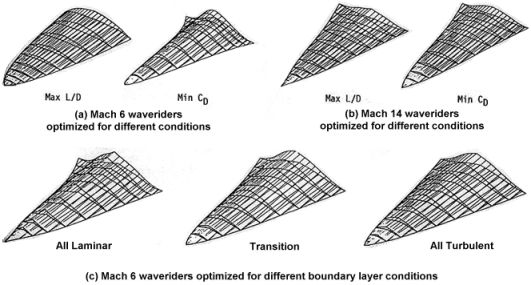RGClark
Mathematician
- Joined
- Jan 27, 2010
- Messages
- 1,635
- Reaction score
- 1
- Points
- 36
- Location
- Philadelphia
- Website
- exoscientist.blogspot.com
SpaceX prefers vertical powered landing to horizontal winged landings for their booster to do RTLS since it requires little modification to the booster and because it would also work on airless bodies. However, using wings may offer an advantage. Based on the lengths of the burns for the return portion of the boosters flight on the Orbcomm-2 mission, I estimate the amount of propellant that must be reserved for the booster RTLS as ca. 46 metric tons (mT). This results in a large performance hit of a 30% loss of payload according to Musk.
However, estimates of wing weight are about 10% of the landed weight, which probably could be reduced to 5% with carbon composites. So for a F9 booster with an estimated dry mass of 20 mT to 25 mT, you would only need an additional 2 to 2.5 mT, and likely half that with composites. This would result in large reduction of the payload loss.
But the question is could we use wings to allow a RTLS when the booster flies at hypersonic speeds, say, at ca. Mach 7? I think it might be possible, or with minimal propellant burn, if your airfoil has high hypersonic lift-drag ratio. To be sure this would be very different from the Space Shuttle's delta-wing shape. The shuttle has been described as akin to a flying brick with a hypersonic L/D ratio of only 1, though its subsonic L/D is better at about 4.5
However, airfoils of high hypersonic L/D are known:
Waverider Design.

http://www.aerospaceweb.org/design/waverider/waverider.shtml
So my challenge to Orbiter-mavens such as on the DG2 is if you have a Mach 7 L/D of about 7, could your first stage booster at a max speed of Mach 7 do a return to launch site?
Note this is a more difficult problem than just gliding down, continuing in the same direction, to land downrange. In that case you can just have large wings like the shuttle to provide high drag to slow down the speed, and then allow the wings to do a slow subsonic landing.
But to do RTLS, not just land downrange, you need to be able to turn around via aerodynamics alone, not burning engines, at hypersonic speed. That high speed means you need high aerodynamic force to turn around, hence the need for high L/D ratio.
This modeling of the descent at hypersonic speed, as the altitude reduces and air density increases while the vehicle is banking, turning all the while is non-trivial.
Bob Clark
However, estimates of wing weight are about 10% of the landed weight, which probably could be reduced to 5% with carbon composites. So for a F9 booster with an estimated dry mass of 20 mT to 25 mT, you would only need an additional 2 to 2.5 mT, and likely half that with composites. This would result in large reduction of the payload loss.
But the question is could we use wings to allow a RTLS when the booster flies at hypersonic speeds, say, at ca. Mach 7? I think it might be possible, or with minimal propellant burn, if your airfoil has high hypersonic lift-drag ratio. To be sure this would be very different from the Space Shuttle's delta-wing shape. The shuttle has been described as akin to a flying brick with a hypersonic L/D ratio of only 1, though its subsonic L/D is better at about 4.5
However, airfoils of high hypersonic L/D are known:
Waverider Design.

http://www.aerospaceweb.org/design/waverider/waverider.shtml
So my challenge to Orbiter-mavens such as on the DG2 is if you have a Mach 7 L/D of about 7, could your first stage booster at a max speed of Mach 7 do a return to launch site?
Note this is a more difficult problem than just gliding down, continuing in the same direction, to land downrange. In that case you can just have large wings like the shuttle to provide high drag to slow down the speed, and then allow the wings to do a slow subsonic landing.
But to do RTLS, not just land downrange, you need to be able to turn around via aerodynamics alone, not burning engines, at hypersonic speed. That high speed means you need high aerodynamic force to turn around, hence the need for high L/D ratio.
This modeling of the descent at hypersonic speed, as the altitude reduces and air density increases while the vehicle is banking, turning all the while is non-trivial.
Bob Clark
